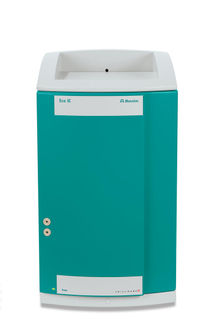To use all functions of this page, please activate cookies in your browser.
my.chemeurope.com
With an accout for my.chemeurope.com you can always see everything at a glance – and you can configure your own website and individual newsletter.
- My watch list
- My saved searches
- My saved topics
- My newsletter
Piperazine
Piperazine is an organic compound that consists of a six-membered ring containing two opposing nitrogen atoms. Piperazine exists as small alkaline deliquescent crystals with a saline taste. The piperazines are a broad class of chemical compounds, many with important pharmacological properties, which contain a core piperazine functional group. Product highlight
Origin and namingPiperazines were originally named because of their chemical similarity with piperidine, a constituent of piperine in the black pepper plant (Piper nigrum). Piperidine itself is found in fireant venom and is the cause of the burning sensations from the bites of these insects. ChemistryPiperazine is freely soluble in water and ethylene glycol, but insoluble in diethyl ether. It is a weak base with a pKb of 4.19; the pH of a 10% aqueous solution is 10.8-11.8. Piperazine readily absorbs water and carbon dioxide from the air. Although many piperazine derivatives occur naturally, piperazine itself can be synthesized by reacting alcoholic ammonia with 1,2-dichloroethane; by the action of sodium and ethylene glycol on ethylene diamine hydrochloride; or by reduction of pyrazine with sodium in ethanol. Piperazine Derivatives as DrugsPiperazine was introduced to medicine as a solvent for uric acid. When taken into the body the drug is partly oxidized and partly eliminated unchanged. Outside the body, piperazine has a remarkable power to dissolve uric acid and producing a soluble urate, but in clinical experience it has not proved equally successful. Lycetol, lysidine and sidonal are compounds having similar action. Many piperazine derivatives are notable successful drugs, including:
As an anthelminticPiperazine was first introduced as an anthelmintic in 1953. A large number of piperazine compounds have anthelmintic action. Their mode of action is generally by paralysing parasites, which allows the host body to easily remove or expel the invading organism. This action is mediated by its agonist effects upon the inhibitory GABA (γ-aminobutyric acid) receptor. Its selectivity for helminths is because vertebrates only use GABA in the CNS and the helminths' GABA receptor is a different isoform to the vertebrate's one. Piperazine hydrate and piperazine citrate are the main anthelminthic piperazines. These drugs are often referred to simply as "piperazine" which may cause confusion between the specific anthelmintic drugs and the entire class of piperazine-containing compounds. Other usesPiperazines are also used in the manufacture of plastics, resins, pesticides, brake fluid and other industrial materials. Piperazine ferulate tablets are used as a Chinese herb and in one patient resulted in elevated liver enzymes when taken during treatment for latent tuberculosis infection with isoniazid (INH). Stopping both Chinese herb and INH brought liver enzymes back to normal range within 1 month. References
See alsoThis article incorporates text from the Encyclopædia Britannica Eleventh Edition, a publication now in the public domain.
Categories: Amines | Piperazines |
|||||||||||||||||||||||||||||||||||||||||||||
| This article is licensed under the GNU Free Documentation License. It uses material from the Wikipedia article "Piperazine". A list of authors is available in Wikipedia. | |||||||||||||||||||||||||||||||||||||||||||||







